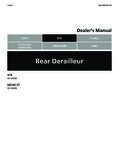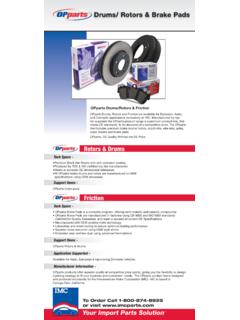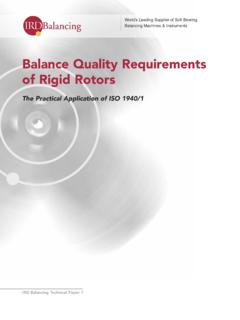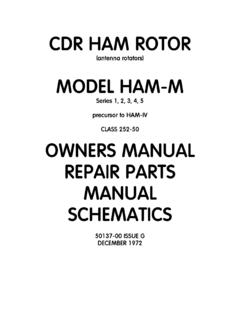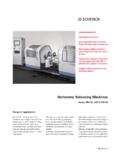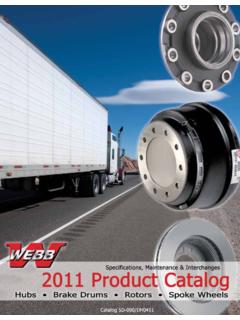Transcription of General Safety Information 203 / 180 mm rotors - …
1 General Safety InformationIn order to realize the best performance, we recommend that the followingcombination be LeverRotorBR-M445/M446BL-M445/T445SM-RT5 3 (160mm)SM-RT53M (180mm)SM-RT53L (203mm)SM-RT51SM-RT51M Installation of the brake lever (BL-M445/T445)Secure the brake lever as shown in the illustration. (Check that the brake lever does not interferewith the shifting lever during operation. Refer to the Service Instructions for the shifting lever types might require the shifting lever to be installed first, due to the position of the shiftinglever fixing bolts.)Brake lever Tightening torque: 6 - 8 N m {53 - 69 in. lbs.}Operate the brake lever several times and check whether the brakes operate normally ornot. Also check that there are no oil leaks C-shaped guides and theusual type of cable stoppers,use the special Shimanocable supporter (soldseparately) to secure asshown in the illustration.
2 < C-shaped guide > < Usual type of cable stopper >Tightening torque: - N m { - in. lbs.}Cable SupporterMineral OilBrake pad unit SM-HANGHoseSM-BH59SM-DB-OILB01S (Resin pads)Technical Service InstructionsSI-8J50A-002 Disc Brake System( For Cross-Country )WARNING Please use extra caution to keep your fingers away from the rotatingdisc brake rotor during installing or servicing the wheel. The rotor issharp enough to inflict severe injury to your fingers if caught within theopenings of moving rotor. The 203 mm and 180 mm rotors provide a higher braking force than the 160 mm sure that you have a complete feel for the braking characteristics before using thebrakes. The calipers and rotor will become hot when the brakes are operated, so do not touchthem while riding or immediately after dismounting from the bicycle, otherwise you mayget burned.
3 Check that the brake components have cooled down sufficiently beforeattempting to adjust the brakes. The required braking distance will be longer during wet your speed and apply the brakes early and gently. If the road surface is wet, the tires will skid more easily. If the tires skid, you may fall offthe bicycle. To avoid this, reduce your speed and apply the brakes early and gently. Always make sure that the front and rear brakes are working correctly before you ridethe bicycle. Be careful not to allow any oil or grease to get onto the rotor and brake pads, otherwisethe brakes may not work correctly. If any oil or grease do get on the pads, you should replace the any oil or grease gets on the rotor, you should clean the rotor. Ifthis is not done, the brakes may not work correctly. Before riding the bicycle, check that the thickness of each pad is or more.
4 If noise occurs when the brakes are operated, it may indicate thatthe brake pads have worn down to their usage limit. After checkingthat the brake system has cooled down sufficiently, check the brakepad the brake pads if the pad wear indicators are visible. Vapor lock may occur if the brakes are applied continuously. Torelieve this condition, momentarily release the lever. Use only genuine Shimano mineral oil. If other types of oil are used, it may causeproblems with brake operation, and cause the system to be unuseable. Be sure to use only oil from a freshly-opened container, and do not re-use oil which hasbeen drained from the bleed nipple. Old oil or already-used oil may contain water whichcould cause vapor lock in the brake system. Be careful not to let water or air bubbles to get into the brake system, otherwise vaporlock may occur.
5 Be particularly careful when removing the cover of the reservoir tank. If cutting the brake hose in order to adjust the length of the hose, or when changing overthe brake hose from left to right or vice versa, be sure to bleed the air from the hose bycarrying out steps (5), (8) to (10) given in Adding mineral oil and bleeding air in theService Instructions. When turning the bicycle upside down or on its side the brake system may have someair bubbles inside the reservoir tank which are still there when the reservoir tank cover isreplaced, or which accumulate in various parts of the brake system when it is used forlong periods. This disc brake system is not designed to be turned upside down. If thebicycle is turned upside down or on its side, the air bubbles inside the reservoir tank maymove in the direction of the calipers.
6 If the bicycle is ridden in this condition, there is thedanger that the brakes may not operate and a serious accident could occur. If the bicycle has been turned upside down or on its side, be sure to operate the brakelever a few times to check that the brakes operate normally before riding the bicycle. Ifthe brakes do not operate normally, adjust them by the following procedure. If fluid leaks occur, immediately stop using the brakes and carry out the appropriaterepairs. If you continue riding the bicycle while fluid is leaking, there is the danger thatthe brakes may suddenly stop working. If the quick release lever is on the same side as the rotor, there is the danger that it mayinterfere with the rotor, so check that it does not interfere. It is important to completely understand the operation of your bicycle's brake use of your bicycle's brake system may result in a loss of control or anaccident, which could lead to severe injury.
7 Because each bicycle may handledifferently, be sure to learn the proper braking technique (including brake lever pressureand bicycle control characteristics) and operation of your bicycle. This can be done byconsulting your professional bicycle dealer and the bicycle's owners manual, and bypracticing your riding and braking technique. If the front brake is applied too strongly, the wheel may lock and the bicycle mayfall forward, and serious injury may result. The M445/M446 disc brakes are designed for optimum performance whenused in combination with the BR-M445/M446 (calipers), BL-M445/T445(brake lever), SM-RT53 / RT51 (rotor) and Shimano pad unit (B01S). Shimano disc brake systems are not compatible with tandem tandem bicycles have a high overall weight, the load on the brake systemincreases during brake operation.
8 If hydraulic disc brakes are used with tandembicycles, the oil temperature will become too high and vapor locks or ruptures in thebrake hoses may occur, and this will cause the brakes to fail. Obtain and read the service instructions carefully prior to installing the ,worn or damaged parts may cause the bicycle to fall over and serious injury may occuras a result. We strongly recommend only using genuine Shimano replacement parts. Read these Technical Service Instructions carefully, and keep them in a safe place forlater reference.< If brake operation is sluggish when the lever is depressed >Set the brake lever so that it is parallel to the ground, and then gently depress thebrake lever several times and wait for the bubbles to return to the reservoir tank. Itis recommended that you then remove the reservoir tank cover and fill the reservoirtank with mineral oil until no bubbles the brakes still operate sluggishly, bleed the air from the brake system.
9 (Refer to "Adding the mineral oil and bleeding air".)Vapor lock is a phenomenon in which the oil inside the brake system becomesheated, which causes any water or air bubbles inside the brake system to can then result in a sudden increase in the brake lever Handling the mineral oil Use Safety glasses when handling, and avoid contact with eyes. Contact with eyes mayresult in irritation. In the event of eye contact, flush with fresh water and seek medicalassistance immediately. Use gloves when handling. Contact with skin may cause a rash and the event of skin contact, wash well with soap and wearindicators Inhalation of oil mist or vapors may cause nausea. Cover nose and mouth witha respirator type mask and use in a well ventilated area. If mist or vapor isinhaled, go immediately to an area with fresh air.
10 Cover up with a blanket. Staywarm and stable and seek professional medical advice. Do not drink. May cause vomiting or diarrhea. Keep out of reach of children. Do not cut, heat, weld or pressurize the oil container, as this may causeexplosion or fire. Disposal of Used Oil : Follow local county and/or state codes for disposal. Usecare when preparing oil for disposal. Directions : Keep the container sealed to prevent foreign objects and moisturefrom getting inside, and store it in a cool, dark area away fromdirect sunlight or heat. Burn-in period Disc brakes have a burn-in period, and the braking force will gradually increaseas the burn-in period progresses. Make sure that you are aware of any suchincreases in braking force when using the brakes during the burn-in period. Thesame thing will happen when the brake pads or rotor are replaced.






